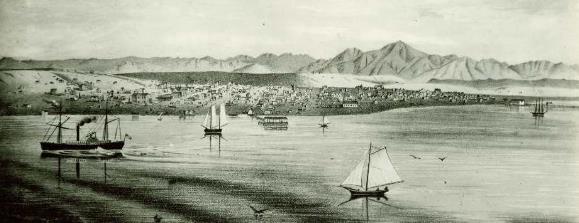
Jubilation greeted the opening of the Sweetwater Dam in the spring of 1888. On the heels of the great land “boom of the eighties,” National City and the south bay reveled in the completion of an engineering marvel, the tallest masonry arch dam in the United States, which created San Diego County’s first large reservoir of water–an essential key to the region’s growth and prosperity.
The story of Building the Sweetwater Dam.
Kelp–best known as “the flyblown brown seaweed that fouls beaches and tangles the legs of ocean swimmers” is actually one of San Diego’s great natural products. In the early 1900s, the processing of ocean kelp by the Hercules Powder Company in a huge plant in Chula Vista employed hundreds of people and helped win a war. The story of Hercules Powder.
To look at it now, solidly in place, you would never know its disturbed history. The broken course of the Sutherland project is one of those fantastic things that could only happen here. –Shelley Higgins, former City Attorney, in This Fantastic City.
The story of the ill-starred Sutherland Dam, known in its day as a A Dam Fiasco.
We arrived at San Diego very tired at ½ past 7. Did not know where to go or what to do. It was dark. A serious time. At length, Walter, Keane, and self were taken in at the Dragoon Quarters and the rest got a tent. Our supper was coffee and crumbs of biscuit. –H.M.T. Powell, December 3, 1849
The diary of a tired traveler from Illinois provides a rare, colorful account of early San Diego. Of an estimated 80,000 gold-seekers who found their way to California in 1849, relatively few stopped in San Diego. Fewer still left recorded narratives of their time here. The journal of H.M.T. Powell, published in 1931 as The Santa Fe Trail to California, 1849-1852, is considered by historians to be one of the most important accounts of the Gold Rush era.
An eyewitness view of Old Town San Diego in 1849: H.M.T. Powell and San Diego
San Diego is now the automobile racing capital of America. For the brief space of one week the Southern California exposition city is to revel in all the glory of the speed game. Next Saturday America’s foremost drivers are to risk their lives . . . in one of the most unique motor races ever staged on the Pacific Coast. –Los Angeles Times, Jan. 3, 1915
The story of the 1915 Exposition Road Race.
For the first time in the history of aviation, Glenn H. Curtiss yesterday performed the feat of launching his hydro-aeroplane from the water into the air, and after remaining in the air one minute and 21 seconds, alighted upon the water. He repeated his performance at will, skipping about Spanish Bight, off North Island, and circling around the craft in the harbor, with the ease and grace of the ordinary sea-bird. –San Diego Union, January 27, 1911.
The early months of 1911 would be a remarkable time in the history of aviation, particularly for pioneer flyer Glenn Curtiss. The 33-year-old former motorcycle racer was America’s most accomplished aviator: winner of prestigious speed races, a successful aircraft builder, a respected consultant to the military, and the first aviator to fly and land a plane on water. The story of The Aviator.
San Diego by nature offers the finest spot in the United States for tourists. And tourism is our largest non-government business. [Mission] Valley is part of the Planning Department’s future plan for the tourist, and we are considering throwing it down the drain . . . –Arthur Jessop, downtown merchant, June 26, 1958.
Controversial decisions in city planning are not new in San Diego but perhaps no action has ever been more consequential than a City Council vote in June 1958 to rezone 90 acres of farmland along Interstate 8–a decision that green-lighted construction of the Mission Valley Shopping Center.
Just a reminder, folks. This Wednesday, December 3, I’ll be at the North Park branch of the Public Library to share some local history stories and photos from San Diego Yesterday. 6:30 p.m. at 3795 31st St. See you there!
The great need of this town is about to be supplied by A. E. Horton, Esq., who will immediately erect, on the northwest corner of Fourth and D Streets, a palatial brick edifice, for hotel purposes. It is to contain a hundred rooms and to be fitted up with elegant furniture and all modern improvements. –The San Diego Bulletin, December 18, 1869
The story of San Diego’s first hotel, the luxurious Horton House Hotel.
Save the date. On December 3, I’ll be at the North Park branch of the Public Library to share some great stories and photos from San Diego Yesterday. That’s 6:30 p.m. at 3795 31st St.
San Diego (619) 533-3972.












